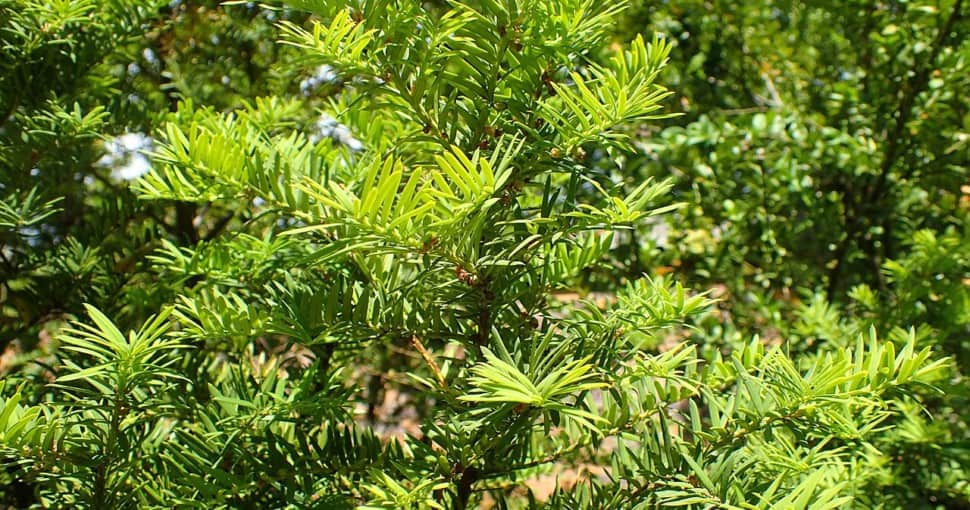Want to increase your knowledge of the poisonous plants in Illinois? The Prairie State is home to a large variety of poisonous plants that can cause dermatitis upon direct contact, and ingestion can result in many different health conditions. Read on to discover all the toxic plants in Illinois!
Contents
- 1. Castor Bean (Ricinus communis)
- 2. Dumb Canes (Dieffenbachia)
- 3. Hyacinth (Hyacinthus)
- 4. Daffodil (Narcissus)
- 5. Rosary Pea (Abrus precatorius)
- 6. Poison Hemlock (Conium maculatum)
- 7. Poison Oak (Toxicodendron diversilobum)
- 8. Azaleas (Rhododendron)
- 9. Canada Yew (Taxus canadensis)
- 10. Larkspur (Delphinium)
- 11. Foxgloves (Digitalis)
- 12. Lily of the Valley (Convallaria majalis)
- 13. Morning Glory (Ipomoea)
- 14. Mother-In Law-Tongue/Snake Plant (Dracaena trifasciata)
- 15. Philodendron (Philodendron)
- 16. Poison Ivy (Toxicodendron radicans)
- 17. Spurges (Euphorbia)
- 18. Giant Hogweed (Heracleum mantegazzianum)
- 19. Queen Anne’s Lace/Wild Carrot (Daucus carota)
- 20. Stinging Nettle (Urtica dioica)
- 21. Pencil Cactus (Euphorbia tirucalli)
- 22. Oleander (Nerium oleander)
- 23. Dogbane/Indian Hemp (Apocynum cannabinum)
- 24. Jack-in-the-Pulpit/Indian Turnip (Arisaema triphyllum)
- 25. Hemp (Cannabis sativa)
Illinois has a vast landscape, home to different flora and fauna, including many poisonous herbs, weeds, bulbs, shrubs, vines, and trees. These annual, perennial, and biennial plants can be growing in plain sight, amidst your ornamental plants, alongside roads, on empty plots, in forests and prairies, and along hiking trails and rivers.
The truth is that most poisonous plants growing in the Prairie State look innocent, but they have a poisonous sap, roots, leaves, flowers, stems, etc. Depending on the plant you come across, it can have toxins that affect the skin and cause blisters, rashes, and itching, or it can have poisonous flowers, seeds, and leaves that can cause nausea, vomiting, swelling of the lips, and other internal issues upon ingestion.
Depending on where you go in Illinois, you might come across Hyacinths, Poison Hemlock, Azaleas, Foxgloves, and other types of poisonous plants. If you have ample knowledge about these plants, you can keep yourself, your kids, and your pets out of harm’s way.
So, without ado, here are 25 poisonous plants in Illinois that you should not plant in your garden and keep away from:
1. Castor Bean (Ricinus communis)
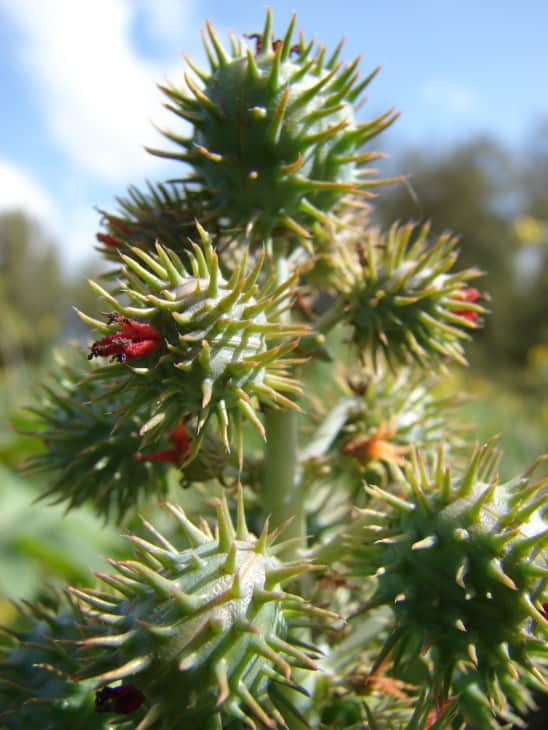
Also known as the African Wonder Tree, Castor Bean is an annual herbaceous, cultivated, ornamental tree native to Africa. It contains highly poisonous leaves and seeds that cause immediate nausea, abdominal pain, bloody diarrhea, vomiting, depression, colic, sweating, difficulty breathing, fever, convulsions, coma, and fatality. Skin contact can cause a severe allergic reaction in certain people. This plant has red-purplish stems, green, alternate, simple, large, compound leaves, and small, white, gold, or red/burgundy blossoms.
2. Dumb Canes (Dieffenbachia)
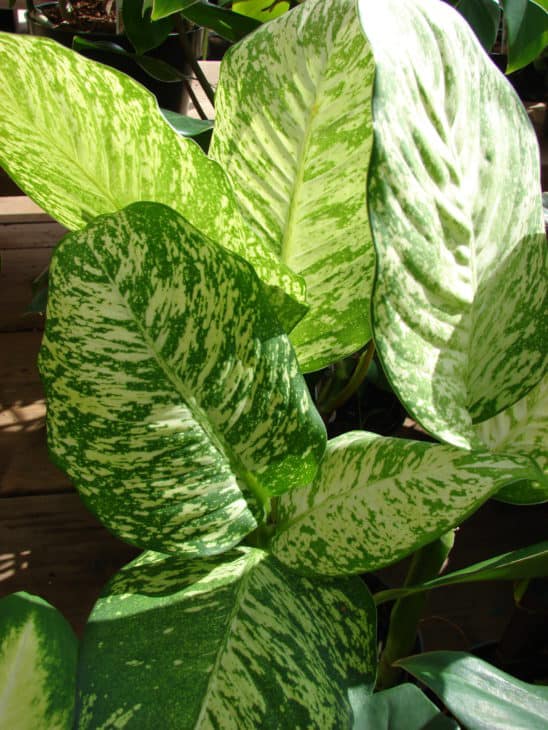
Dumb Cane is a houseplant with variegated leaves with yellow and cream markings. It is a poisonous plant with an acrid sap that will cause numbness of the throat and vocal cords upon ingestion. The sap will also irritate the skin and damage the cornea. It can cause excessive drooling and vomiting. This plant features green stems and large, oblong leaves with bands around the outer edge. It also develops berry-like fruits and insignificant green blooms.
3. Hyacinth (Hyacinthus)
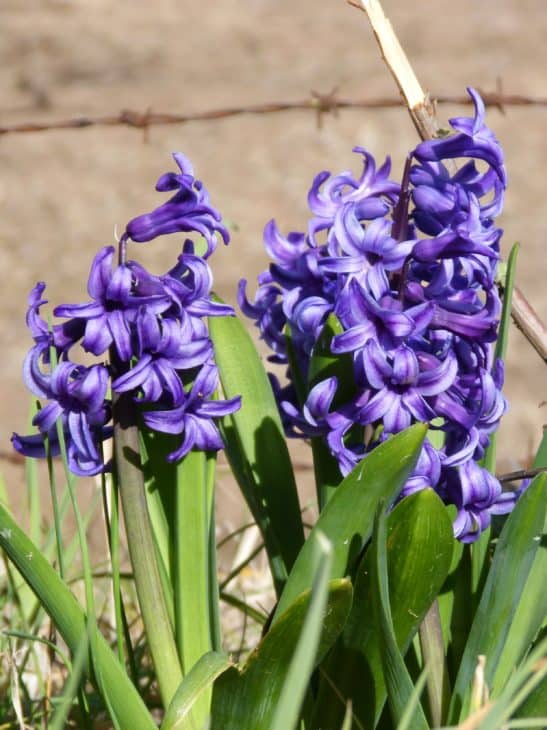
Native to Europe and Asia, Hyacinth is a small genus of spring-blossoming, bulbous perennials that grow spikes of fragrant blossoms in multiple colors, including pink, white, mauve, and purple. It also features strap-shaped leaves. Hyacinth bulbs are poisonous as they contain oxalic acid. Handling the bulbs can result in mild skin irritation. It’s why you should wear gloves when coming into contact with them.
4. Daffodil (Narcissus)
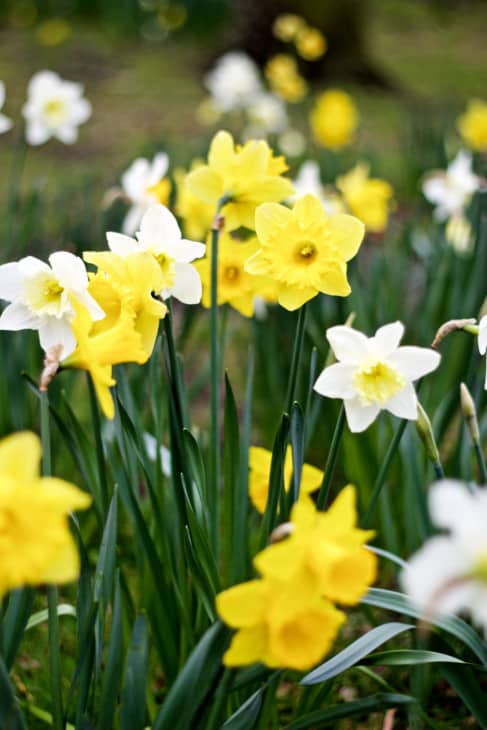
Also known as Tazettas, the Daffodil is a poisonous, perennial bulb that features pink, orange, gold, white, and variegated blooms that are showy, scented, and star or trumpet-shaped. It features deciduous, waxy, simple, rosulate, narrow, strap-shaped, green leaves. Daffodil plants are toxic when eaten in large quantities. They can cause vomiting, diarrhea, nausea, salivation, convulsions, and trembling. This plant also causes contact dermatitis, i.e., a severe skin rash. The bulbs can cause cardiac arrhythmias and low blood pressure.
5. Rosary Pea (Abrus precatorius)
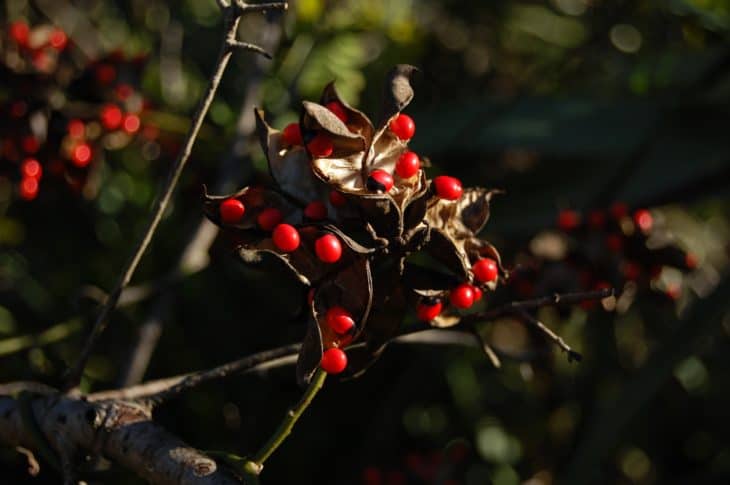
Also known as Crab’s Eyes, Rosary Pea is a poisonous plant with highly poisonous seeds. If you ingest the seeds of this plant, you will experience severe abdominal pain, nausea, vomiting, fever, shock, diarrhea, tremors, high heart rate, and burning in the throat. It can also be fatal. It is native to tropical regions across the world. Rosary Pea has tiny, white to pink or lavender-pink blooms that grow in clusters in the leaf axils. It has pinnate, compound, deciduous, alternate, green, oval-shaped leaves and black-red, showy fruits.
6. Poison Hemlock (Conium maculatum)
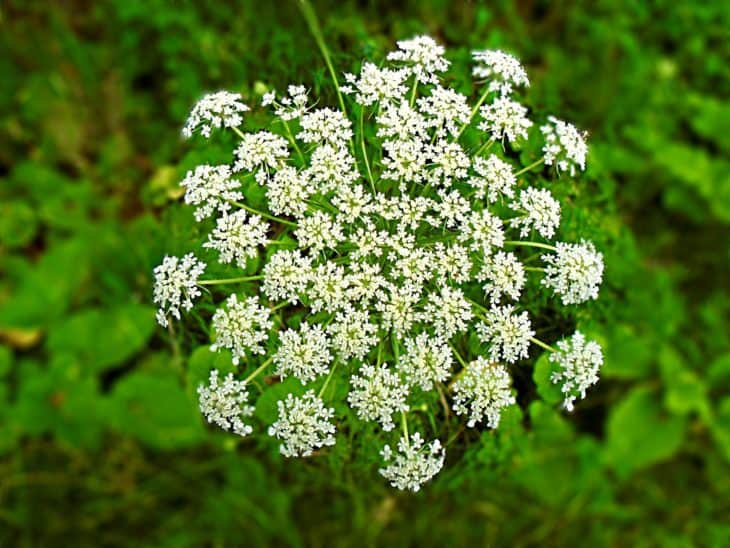
Poison Hemlock is a widespread toxic plant that contains toxic alkaloids and coniine. It is an aggressively-spreading biennial that can grow along rivers, streams, and roadsides and in open-sunny regions and empty lots. You should never touch Poison Hemlock directly or ingest it because it can cause you to suffer from dizziness, paralysis, pupil dilation, and fatality. This herbaceous weed grows stems that have distinctive purple-red spots and streaks. It develops tiny white blooms that grow in umbrella-like clusters. Poison Hemlock also grows fern-like, serrated, bright green leaves with a musty odor.
7. Poison Oak (Toxicodendron diversilobum)
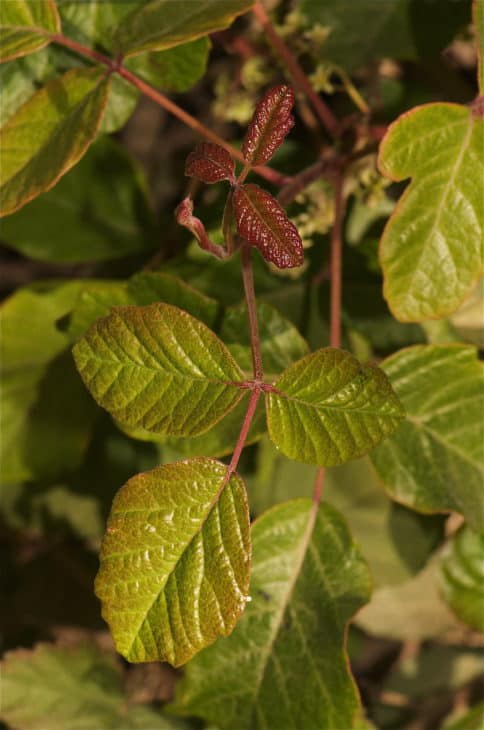
Native to western North America, Poison Oak is a low-growing shrub or upright vine. This plant has scalloped, lobed, and oak leaf-type leaves with serrated margins. The foliage turns orange-brown and red in autumn. Poison Oak can grow as a climbing vine in shaded spots and as a dense shrub in sunlit spaces. This plant has a potent allergen called urushiol. If you come into contact with its damaged, broken, and bruised foliage, its sap will cause your skin to get inflamed and feel itchy. You might even develop blisters and swelling.
8. Azaleas (Rhododendron)
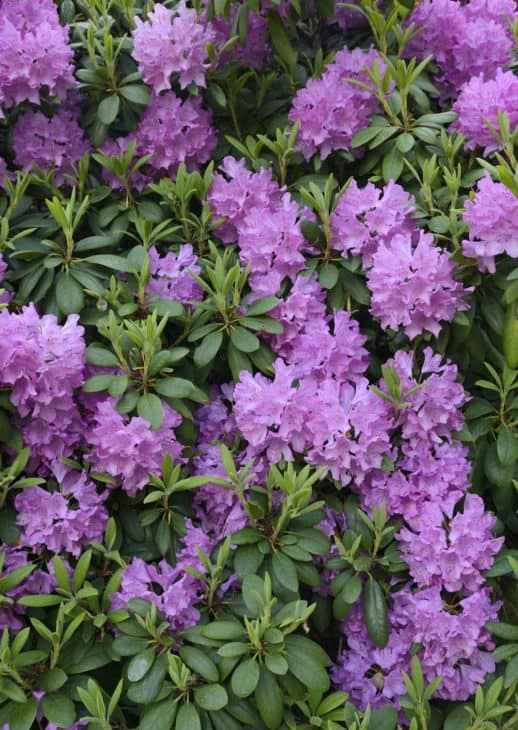
Native to Asia, North America, and Europe, Azaleas are deciduous, ornamental plants loved for their attractive blossoms. However, all flowery Azalea bushes are poisonous because they contain toxins known as grayanotoxins. If you ingest these flowers, you will experience a burning sensation in the mouth, followed by excessive salivation. Azalea bushes often feature fragrant, funnel-shaped blooms with two lips and five projecting stamens.
9. Canada Yew (Taxus canadensis)
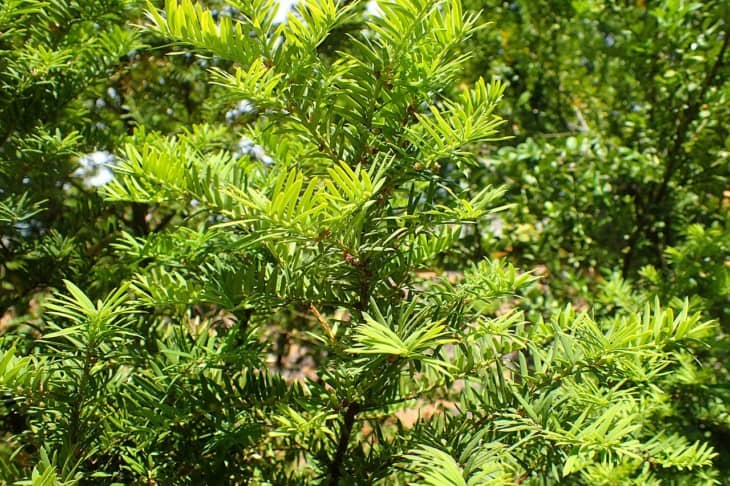
Also known as American Yew, Canada Yew is an evergreen shrub with multiple ascending and horizontally-growing branches covered with flattened, dark green leaves with pointy tips. This monoecious plant has a thin, scaly bark and sporophylls. It grows red, fleshy, berry-like cones. Canada Yew’s seeds and foliage are toxic to livestock and humans, but its red cones are not considered poisonous.
10. Larkspur (Delphinium)
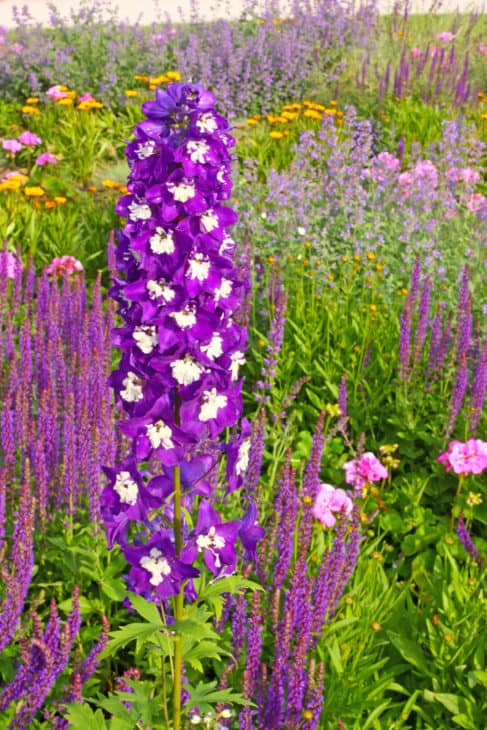
Larkspur is a genus of around 300 species of annual and perennial flowering plants native to the Northern Hemisphere and the high mountains of tropical Africa. It’s divided into three distinct groups based on geographic location and height – the plains larkspur, low Larkspur, and tall Larkspur. This plant thrives in regions that have rich, deep soils. The common part between all Larkspur plants is their prominent blue blossoms and deeply lobed leaves. All parts of Larkspur are toxic, and ingesting them can result in salivation, nausea, bloating, weakness, pulmonary congestion, muscle twitching, and fatality.
11. Foxgloves (Digitalis)
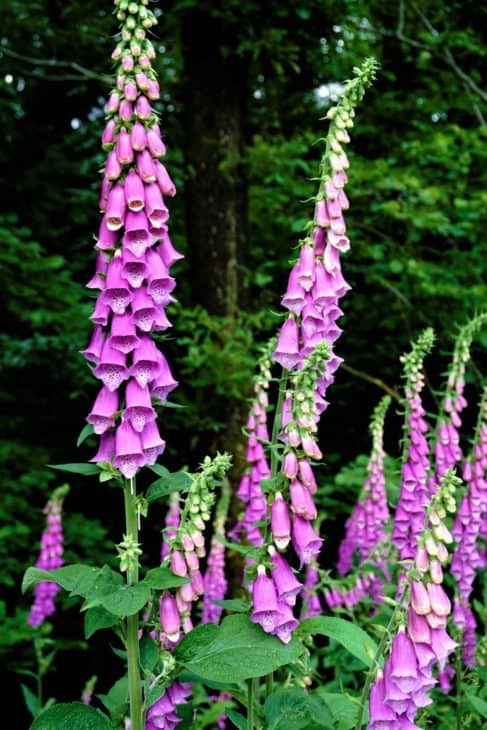
Foxglove is a genus of around 20 species of herbaceous shrub, perennial plants, and biennials. They are native to the Mediterranean, Europe, and the Canary Islands. These plants feature ovate, alternating leaves that grow on their lower stems. The stems are capped by tall, one-sided clusters of bell-shaped, pendulous blooms in purple, white, or yellow hues. All parts of Foxglove contain poisonous cardiac glycosides, and ingesting them can result in severe poisoning, causing headache, nausea, diarrhea, and skin irritation.
12. Lily of the Valley (Convallaria majalis)
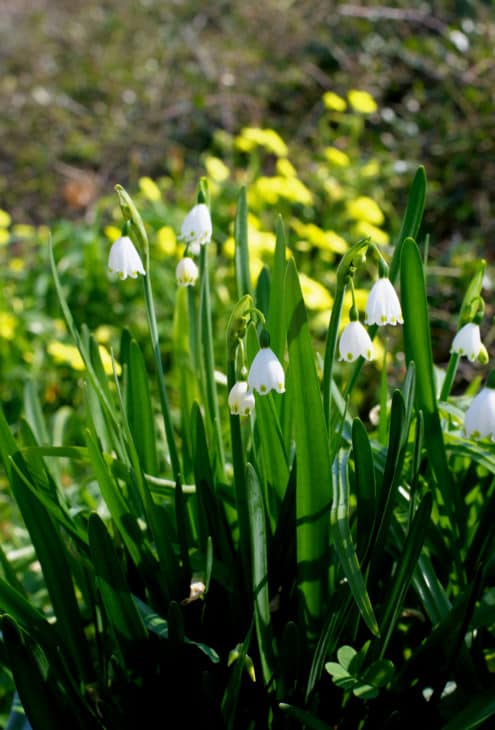
Lilly of the Valle is a scented perennial herb native to eastern North America and Eurasia. It’s also cultivated in shaded gardens in temperate regions across the world. It forms a dense mat that can be used as ground cover. This plant features one-sided clusters of nodding, bell-shaped, white blossoms, red berry-like fruits, and glossy leaves. Lily of the Valley has cardiac glycosides, and ingesting any part of this plan can cause a variety of cardiac arrhythmias, such as rapid, thready pulse, bradycardia, and more. Accidental poisoning can also be fatal.
Alternatives: 9 Plants That Look Like Lily of the Valley
13. Morning Glory (Ipomoea)
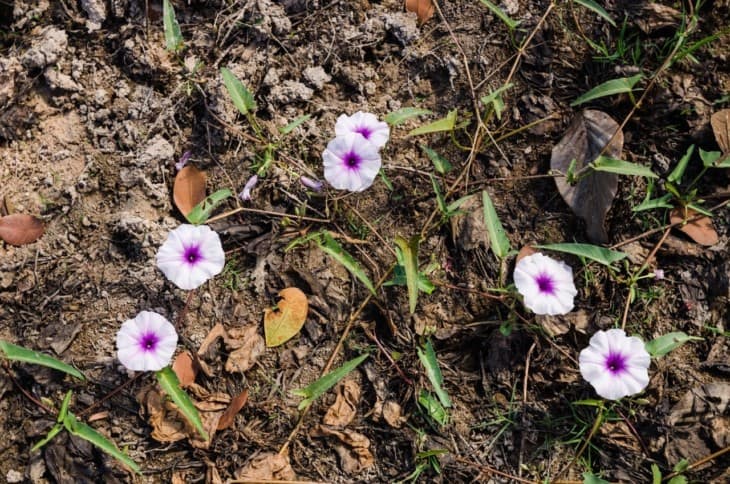
Morning Glory is a quick-spreading, annual, tenacious vine that features funnel or trumpet-shaped lavender, purple, blue, or pink blossoms that open every morning and fade at night. This climbing, deciduous vine has green-hued, simple, alternative, ovate, heart-shaped leaves. Morning Glory has poisonous seeds that cause dilated pupils, nausea, hallucinations, drowsiness, diarrhea, muscle tightness, and numbness of extremities.
14. Mother-In Law-Tongue/Snake Plant (Dracaena trifasciata)
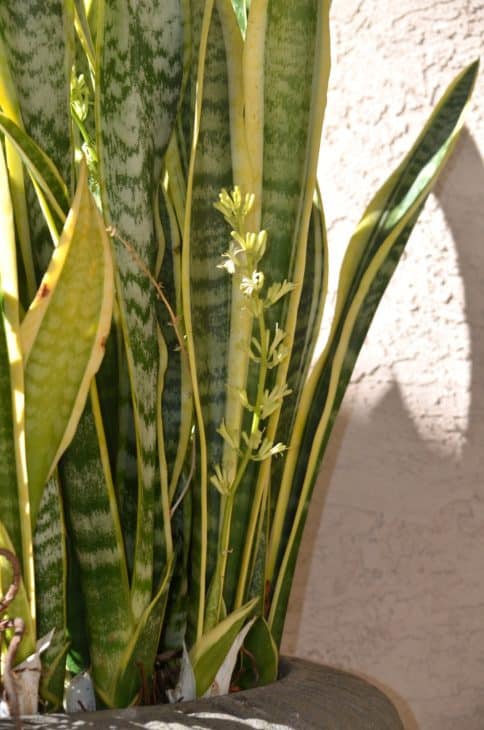
Native to Africa, Snake Plant is an erect, broadleaf, clumping houseplant. This evergreen and durable plant improves indoor air quality and is often grown in containers for indoor use. It features stiff, upright, evergreen, variable-hued, fleshy, leathery, simple, lanceolate leaves that grow in clusters. This plant rarely flowers, but when it blossoms, it bears green or white minute, non-fragrant blooms. Snake Plant contains saponins, which are poisonous to humans. Ingesting this plant can cause diarrhea, vomiting, nausea, excessive salivation, and depression.
15. Philodendron (Philodendron)
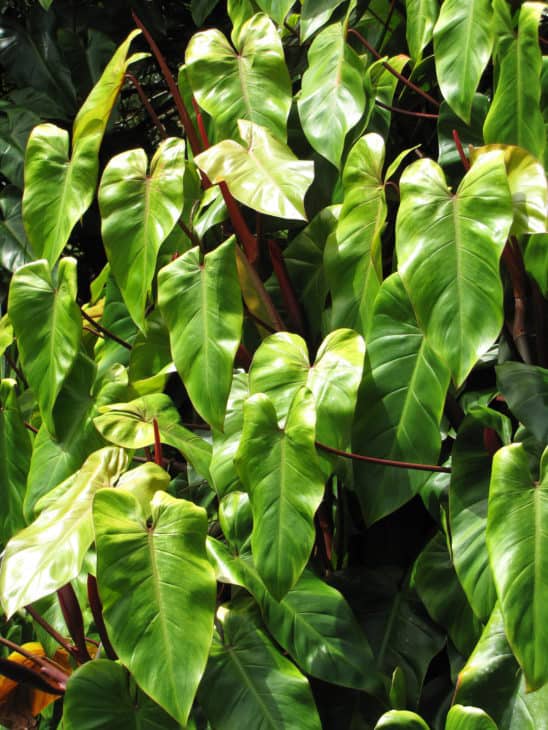
Philodendrons are a genus of 450 species of stout-stemmed, trailing herbs native to tropical America. Many of these plants start as vines and then turn into epiphytes. Their leaves are borne on long petioles and appear before the blooms that are unisex, reddish, white, and yellow-hued. They give way to red-orange fruits. Philodendrons are poisonous plants, and ingesting them can cause swelling and burning of the tongue, lips, and throat, diarrhea, and vomiting.
16. Poison Ivy (Toxicodendron radicans)
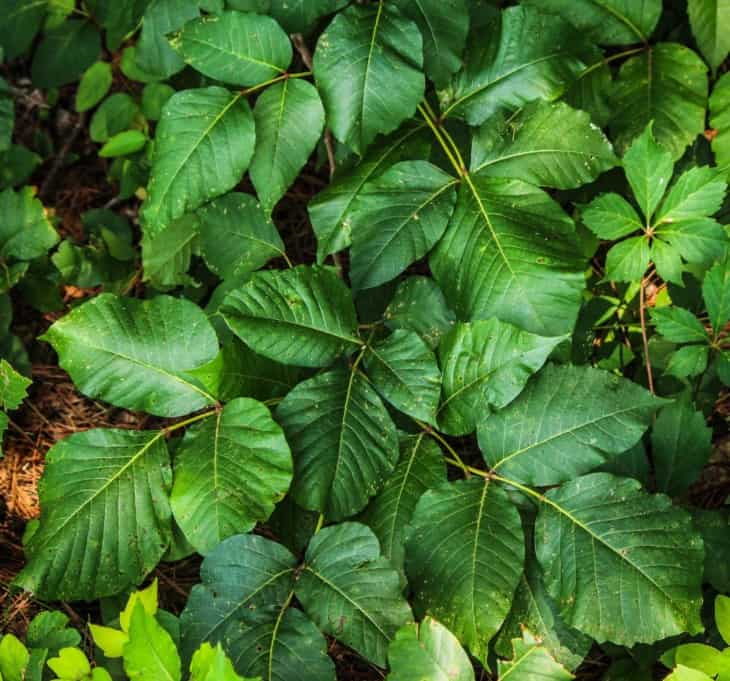
Poison Ivy is a highly toxic plant that has urushiol in its sap. It’s an oleoresin that causes dermatitis, a skin condition in which your skin becomes inflamed, itchy, and develops oozing blisters. Depending on how you grow it, Poison Ivy can grow into a climbing, upright vine or a low, surface-level weed shrub. It develops green or yellow flowers, variable growth, greenish drupes, and serrated, hairy foliage, which can turn red, yellow, and orange in autumn.
17. Spurges (Euphorbia)
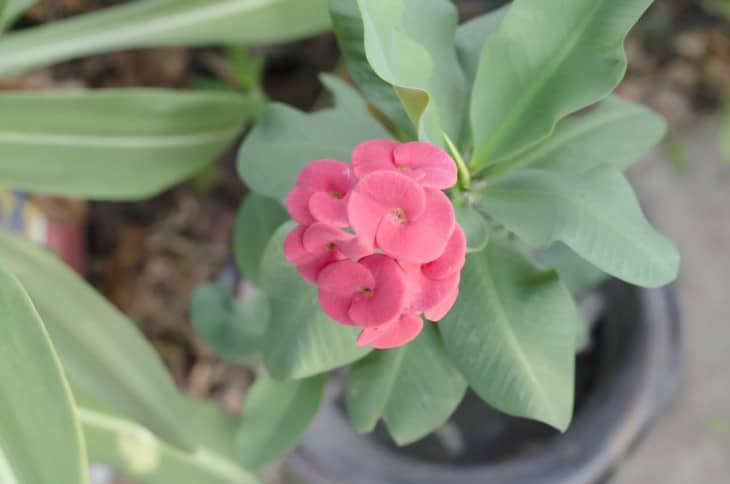
Spurges are a genus of perennial, annual, and biennial herbs, shrubs, and small trees that contain toxic, milky sap. It features tiny, nondescript blooms and clusters of colorful bracts. The sap of Spurges can cause your skin to irritate. If parts of the plant are eaten, it can result in nausea or vomiting. This plant features green leaves with variegated white and yellow stripes. The foliage grows on top of woody branches.
18. Giant Hogweed (Heracleum mantegazzianum)
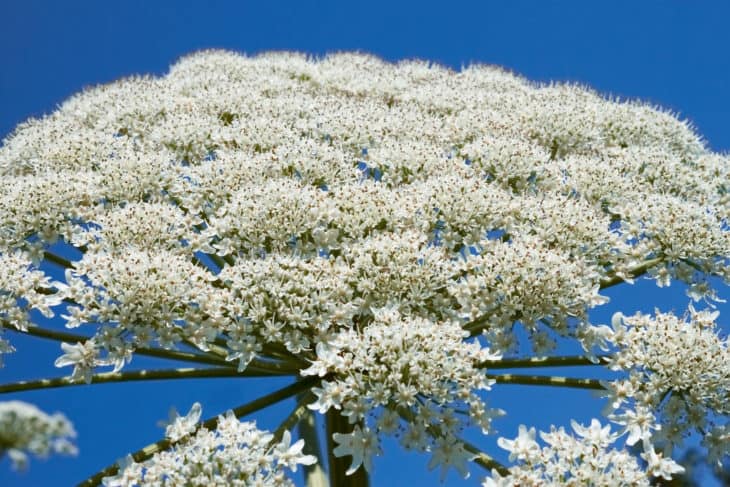
Giant Hogweed is a Georgian and Southern Russian native introduced to the US in the last century. This plant thrives in areas with moist, well-drained soils and abundant sunlight. It grows along rivers, yards, streams, and roadsides. Giant Hogweed is an invasive species that grows ridged, hollow stems and white blossoms that develop in large, compound umbels. It also has compound, massive, incised leaves. Skin contact with Giant Hogweed parts or sap during the day can cause swelling, blistering, and itchiness that will last for months and make your skin UV-sensitive.
19. Queen Anne’s Lace/Wild Carrot (Daucus carota)
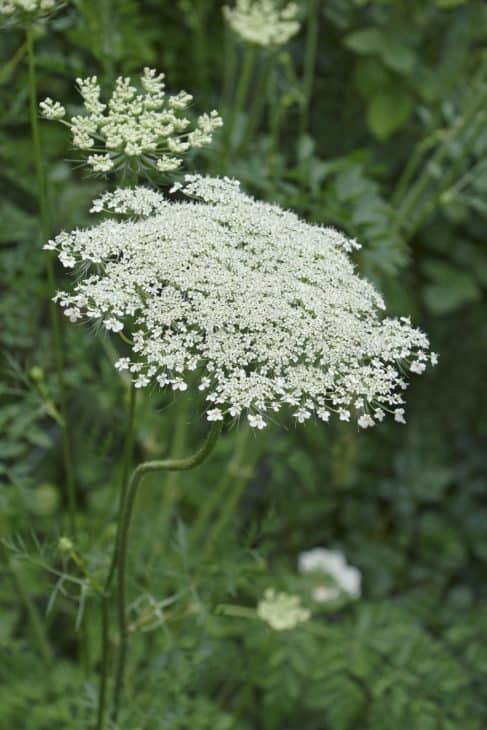
Native to Europe, Queen Anne’s Lace is a wildflower herb naturalized in America. This invasive biennial plant grows along roadsides, waste places, and old fields in sunny or partially shaded areas. It has large, fern-like, arching leaves and massive flattened clusters of tiny white blossoms with dark-colored florets. This plant grows spiky fruit that curls inwards. Wild Carrot contains toxins that can cause dermatitis upon contact with people with sensitive skin. It can cause blistering and irritation.
20. Stinging Nettle (Urtica dioica)
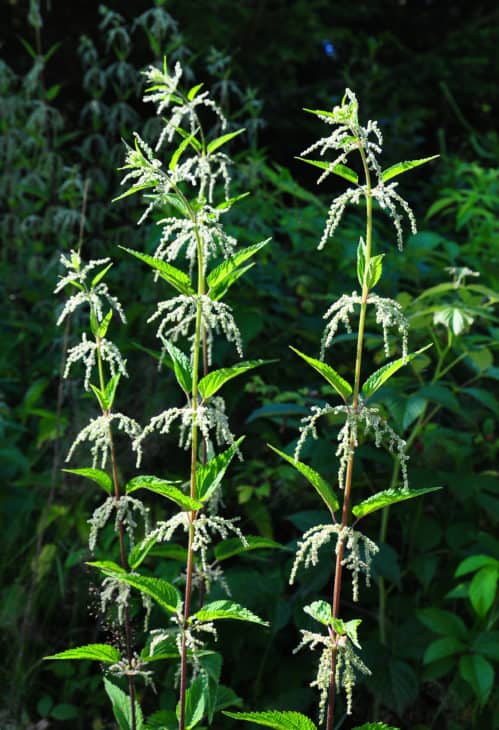
Native to temperate North America and Europe, Stinging Nettle is an herbaceous, weedy, dioecious perennial that grows wonderfully in nitrogen-rich soils. This plant has rigid, upright stems and finely teethed, dark green, opposite, heart-like leaves with tapered ends. It also develops green or white tiny blooms that grow in copious whorled clusters. The foliage of these plants contains hairs or bristles that release a stinging toxin, which can pierce your skin and cause burns and itching.
21. Pencil Cactus (Euphorbia tirucalli)
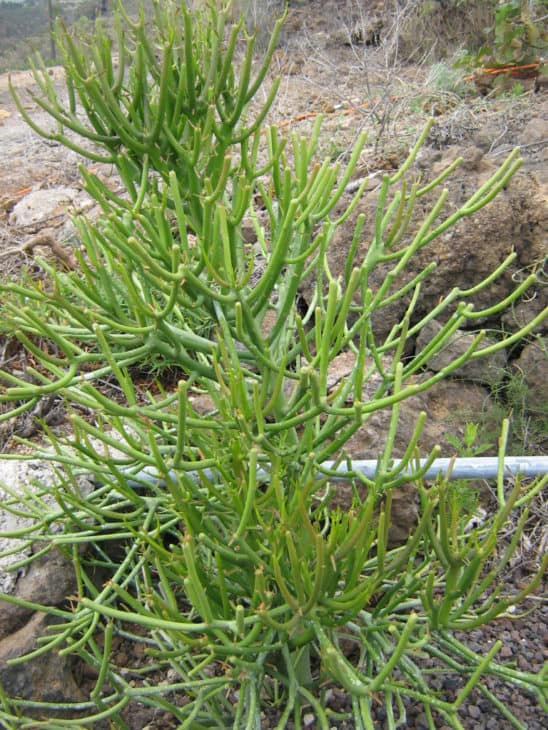
Nicknamed Sticks on Fire, Pencil Cactus is an Indian and South African native euphorbia. It has a milky white latex sap that is strongly irritating. If it gets in the eye, it can cause blindness, and ingesting it can be fatal. This drought-tolerant plant features several slender stems that resemble long sticks or pencils. These stems grow from the base, and in cooler weather, they turn breathtakingly yellow, orange, and pink under bright light.
22. Oleander (Nerium oleander)
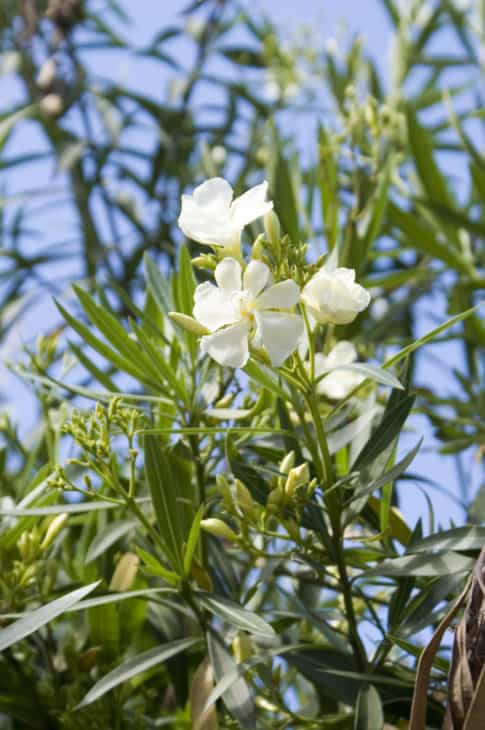
Oleander is an ornamental, blossoming, evergreen shrub native to the Mediterranean. It can be recognized by its shrub-like, tall foliage that grows thick, lanceolate leaves. This flowering plant bears clusters of rose, white, and yellow-hued blooms. It has a poisonous milky sap that creates toxic cardiac glycosides. Unintentional ingestion can result in fatality as the toxin slows down the heart rate.
23. Dogbane/Indian Hemp (Apocynum cannabinum)
Indian Hemp or Dogbane is a North American plant that has erect, purple-toned stems and ascending branches. It grows oval, long, smooth-ended leaves with a yellowish-white or stark white coating. This plant bears tufted seeds in spindle-like pods and tiny, cream-colored flowers that grow in clusters at its branch ends. Indian Hemp can quickly grow into an aggressive weed when left unattended. All of its parts are highly toxic in both dry and fresh forms. It can be fatal when ingested because it can cause cardiac arrest.
24. Jack-in-the-Pulpit/Indian Turnip (Arisaema triphyllum)
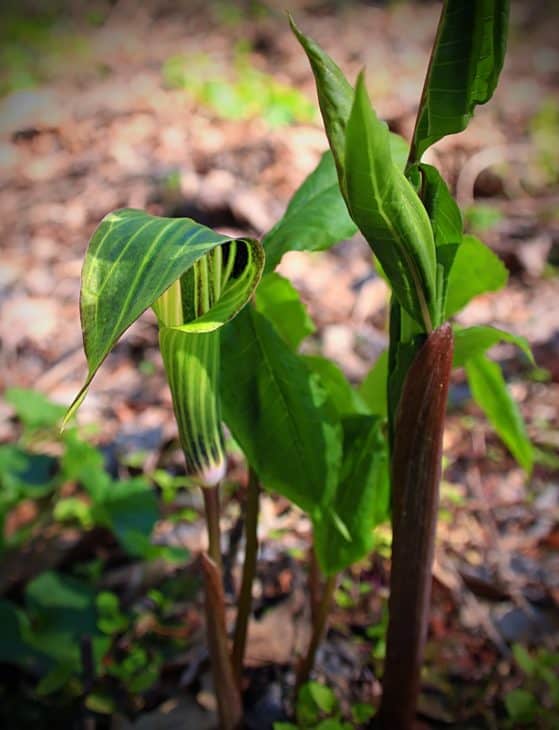
Indian Turnip is a herbaceous perennial woodland plant native to the US. It initially produces only male blooms but becomes hermaphroditic with age. It produces clusters of red berries, green, white, brown, and lavender blooms, and deciduous, green, glossy, compound, ovate leaves. This plant grows in moist woods and forests or along creeks. All parts of the Indian Turnip plant are highly poisonous, and ingesting them can cause severe pain in the mouth, irritation, and swelling of the lips, throat, and tongue, excessive salivation, and vomiting.
25. Hemp (Cannabis sativa)
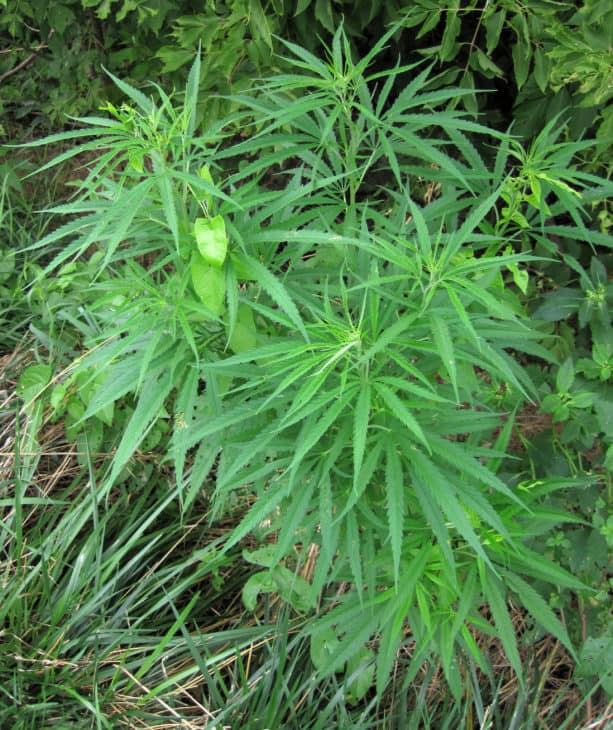
Hemp is a large annual plant native to Russia, South-Eastern Europe, and northwest China. It’s a fast-growing coarse plant with divided, long-stalked, palmate leaves and small, green flowers that grow on crowded axillary clusters. All parts of this plant, including the stems, flowers, and leaves, are toxic. When ingested in large quantities, Hemp can cause hallucinations, stupor, blurriness, delusions, prolonged depression, dilated pupils, vomiting, stupor, low blood pressure, seizures, and coma.

